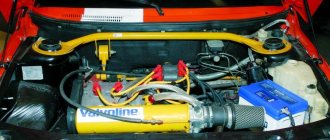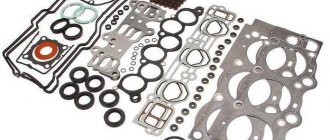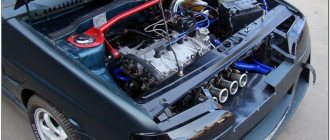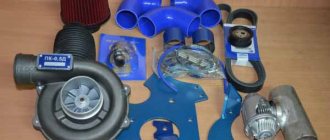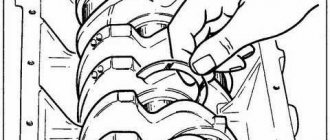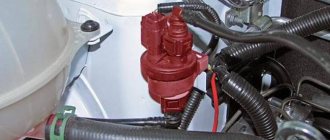The VAZ-11182 engine recently appeared on the market. We analyze the advantages and disadvantages of the VAZ-11182 based on reviews from the owners.
And so, the VAZ-11182 is a thoroughly modified VAZ-11189 engine. The engine has been made more powerful, and torque is now available at minimum speed. What do the owners think about this engine?
The VAZ-11182 engine has been installed on the Lada Largus . In the near future, the new Lada Granta will receive this engine (on May 12, the first batch of Granta cars with a 90-horsepower VAZ-11182 eight-valve engine has already been assembled). The Lada Granta with a new eight-valve engine is already available for sale from May 18.
Need more traction
Largus with a VAZ-11189 engine drove decently. But when the car was loaded to capacity, the lack of power was felt. The Euro-5 standards that arrived in time strangled the engine even more. And the motorists were given a new task - to build a more modern and new motor based on the old block. This is what we saw in serial production on the updated Largus.
The VAZ-11182 engine can be called new. Of the main parts, only the cylinder block remained the same. By the way, it is cast iron, and therefore repairable, unlike similar aluminum parts in many modern engines.
The VAZ-11182 engine can be called new. Of the main parts, only the cylinder block remained the same. By the way, it is cast iron, and therefore repairable, unlike similar aluminum parts in many modern engines.
Despite the insignificant (at first glance) increase in power characteristics, the engine has become more high-torque, and therefore comfortable to drive. And inside he really was completely shaken up.
Technical improvements and changes
The first thing that catches your eye when examining the new 8-clop is a different, higher valve cover. It has a modified crankcase ventilation system. The pipe is now located on the left side. On the 186 engine it is located on the right. The lid, as before, is made of aluminum, although, as far as I know, there were plans to make it from plastic.
The use of a new higher valve cover allowed a new, more efficient oil separator to be installed inside it. Thanks to its use, it was possible to reduce oil carryover with crankcase gases to almost zero.
I think many car owners paid attention and expressed dissatisfaction for the reason that periodically on a VAZ eight-clops vehicle, engine oil begins to leak from under the valve cover during operation. This especially happens at the edges in places of roundings. This was caused by the fact that the valve cover body is attached at only two points and does not press the gasket tightly enough.
The 182 motors have thoroughly worked on this problem. In it, the valve cover is attached at six points. Under it there is a new type gasket. As before, it is silicone and disposable. In accordance with the technical instructions, the tightening torque of the cover must be strictly observed so as not to damage its body. What else can be noted in terms of external changes?
On the right side of the cylinder head there is no longer a massive plug with three mounting bolts and an O-ring, like the 186 engine. Instead, a neat little plug from a VAZ “shesnar” is now used.
A new throttle is also now installed, which has an increased flow area and optimized throttle operation. Also on the 182 engine a new catalytic converter is installed. The exhaust system complies with Euro-5, 6 toxicity standards.
The 182 engine has a modernized ignition system, namely, new spark plugs and high-voltage wires are installed. In terms of physical dimensions and appearance, the spark plugs are very similar to those used in the Nissan H4M engine. But they are original here. I unscrewed the spark plugs and looked, but couldn’t find any markings on them. The thread length has been increased, spark plugs from a 186 engine will not fit here.
A set of original spark plugs for a 186 engine costs an average of 350 rubles. On a modernized engine, this money is only enough for one spark plug. The schedule for replacing them remains unchanged and is every 30 thousand km.
At the bottom of the engine
A new lightweight crankshaft was installed on the VAZ-11182. It has a reduced connecting rod journal diameter (43 instead of 47.8 mm), like the 1.8-liter VAZ-21179 engine. This guarantees good strength and service life: after all, such a neck can withstand the loads of a motor with a power of 122 hp. This will reduce mechanical friction losses.
The diameter of the connecting rod journals has decreased, but the connecting rods and bearings from the VAZ-21179 are wider than they were before. Therefore, the load-bearing capacity of the plain bearing is not affected.
The diameter of the connecting rod journals has decreased, but the connecting rods and bearings from the VAZ-21179 are wider than they were before. Therefore, the load-bearing capacity of the plain bearing is not affected.
The logical step was to use liners and connecting rods from the same VAZ-21179. The piston of the previous eight-valve engine has changed slightly in shape and height, but still remains non-plug-in. The piston rings have been modified to increase service life.
Engine from bottom to top
The crankcase oil pan remains unchanged, it is ordinary steel. The filling volume of the lubrication system is 3.2 liters. For the 186 engine, the heaviest part is the crankshaft, since its design uses as many as 8 counterweights. When designing the new eight-valve engine, great emphasis was placed on reducing the weight of engine parts and mechanical losses.
For this reason, the new crankshaft design uses only 4 counterweights. Thanks to this, it was possible to reduce rotational resistance and inertial losses. Because it is much easier to unwind a part with a smaller mass than a heavier one. In addition, the design of the new crankshaft has reduced the diameter and width of the connecting rod journal.
On the 182 engine, a new connecting rod and piston group is installed. The connecting rod is shorter than the one in the 186 engine. Pistons are supplied by the Motor Detail company in Kostroma. The piston, as before, has a metal-graphite coating. An additional recess is made in it to form a larger combustion chamber. The thickness of the partitions between the piston rings and the length of the skirt have been increased, deeper holes have been made, completely eliminating harmful contact of the piston with the valve in the event of a timing belt break.
Valve adjustment will become more difficult
Previously, adjusting valves required only removing the valve cover, some simple skill, and a set of shims that many owners had accumulated over decades. Now, to adjust the gaps, you will have to raise the camshaft, measure the cups (pushers) and buy new ones for about a thousand apiece. Therefore, it is more profitable to contact the service. Moreover, the gaps will now have to be adjusted less frequently - only every 90,000 km.
A one-piece valve lifter instead of the previous shim design is a step forward. But this step will complicate maintenance for the consumer at high mileage.
A one-piece valve lifter instead of the previous shim design is a step forward. But this step will complicate maintenance for the consumer at high mileage.
16 valve engine
This is a more technically advanced brother of the 8-valve. In fact, it represents a deep modernization of the VAZ-21126 engine. The model received an intake receiver of variable length, due to which its power increased from 98 hp. up to 106 hp
Advantages of a 16-valve engine
If you tune the version with 16 valves, you can reduce the acceleration time of the car to 9 seconds. This is ideal for highways where speeds exceed 100 km/h. At these speeds, the 16-valve model feels more confident in handling.
The design of the internal combustion engine includes hydraulic compensators, which save the machine from zero maintenance with valve adjustment. There is a groove in the engine, so there is no need to be afraid that the valves will be bent.
Disadvantages of the 16-valve engine:
- cost - in some versions of the Lada Granta, the price difference between models with 8 and 16 valves is 100,000 rubles.
In terms of torque, the 16-valve version is inferior to the 8-valve version. To spin the engine to 148 N*m, you will need more than 4000 rpm.
Among the design flaws, it is worth mentioning the problem of spark plug wells sweating with a mileage of 10,000 km or more. Oil begins to drip inside. This is due to the use of sealant rather than gasket as a seal.
Not just “horses”
The engine gained only three horsepower (from 87 to 90 hp). Not much, but the power is needed only when you go to the floor at maximum speed. Much more important is a noticeable increase in traction while driving at low speeds. A torque of 115 Nm is already available at 1000 rpm. It turns out that 80% of the torque is available at the very bottom!
This means that for a good start and acceleration of Largus, you do not need to spin the engine to high speeds. Similar in character to diesel. And such an engine is very suitable for Largus.
From the beginning of 2021, the restyled Largus began to be equipped with an engine that has changed more significantly than the car itself. We replaced most of the large parts and assemblies - more than 20 items!
From the beginning of 2022, the restyled Largus began to be equipped with an engine that has changed more significantly than the car itself. We replaced most of the large parts and assemblies - more than 20 items!
- The main problems of the VAZ 1.6 engine are discussed here.
Photo: AVTOVAZ and “Behind the Wheel”
New VAZ-11182 engine: how it got to Largus
New 8-valve VAZ-11182: how it is designed, due to which the power and torque are increased
Tuning VAZ engines is a trend that has existed for at least 30 years. It’s full of recipes on how to remove 80 hp from an engine. all two hundred “horses”, not to mention an increase in output by 25-30%! But the factory modification differs from tuning, be it “garage” or “branded”, in that engineers are not faced with the task of increasing power at any cost. They must ensure the correct balance of a mass of indicators, many of which are in direct conflict with each other. And the creation of the new VAZ-11182 engine is just an example of such work. Well, to understand this difficult issue, we took advantage of the fact that the head of the calculation and validation bureau of AvtoVAZ power units, Andrei Mikhailovich Avvakumov, was present at the test of the new Lada Largus, which will be equipped with the new engine. It would be simply a sin to miss such an opportunity, and we want to share with you what we managed to find out during a very lengthy conversation.
Perhaps the history of 1.6-liter eight-valve engines can be dated back to 1985, when a 1.5-liter carburetor engine with index 21083 appeared in the VAZ engine range. Initially, it developed 51.5 kW, that is, 70 hp. at 5600 rpm, on AI-93 gasoline, and was obtained from an earlier 1.3-liter VAZ-2108 engine by increasing the diameter of the cylinders. Naturally, this required a lot of radical changes to be made to the design. At the beginning of its life cycle, this engine was under the hood of the Lada Samara and cars of the tenth family.
Engine VAZ-2108
In 1988, a modification of the VAZ-21083 engine appeared, equipped with a modified connecting rod and piston group with a floating piston pin and an original camshaft. The power of the VAZ-2110 engine was 52 kW (70.7 hp), but already on AI-91 gasoline - by that time the USSR was trying to unify the brands of gasoline with Europe. Instead of AI-93, AI-91 and AI-95 appeared. For a number of reasons, the AI-91 did not take root, giving way to the AI-92.
The next important stage was the appearance in 1996 of the VAZ-2111 engine, for the first time in the history of AvtoVAZ equipped with an injection system. This made it possible, while maintaining power at 70 hp, to achieve compliance with Euro-2 emission standards.
Subsequently, several modifications of the VAZ-2111 engine appeared with a power of 51.5 kW (70 hp). up to 56.4 kW (76.7 hp), corresponding to toxicity standards from R83 to Euro-3. Starting with Euro-2 standards, phased fuel injection appeared. Both Lada Samara and 2110 were equipped with VAZ-2111 engines (along with carburetor engines 21083 and 2110).
In 2004, a new 1.6-liter engine with the index 21114/21183 was shown at the exhibition site in Tolyatti. Interesting fact: one engine had two designations, since it was produced in two different workshops. The motors were completely identical.
It was planned to equip VAZ’s new products with the new product – the Kalina and Priora families. The main goal of the modernization was to increase torque at low speeds.
Engine Lada Kalina
This time, the designers increased the volume of the cylinders by increasing the piston stroke and abandoned pairwise parallel fuel injection, settling on phased injection. Replacing the underground neutralizer with a catcollector (a neutralizer installed directly next to the cylinder head) significantly increased the resistance of the exhaust system, but the increase in displacement made it possible to achieve a power of 59.5 kW (80.9 hp)
The engine complied with EURO 3 and 4 emission standards.
Further evolution was associated with the introduction in 2011 of a lightweight connecting rod-piston group, an oval collector with reduced resistance, an electronic throttle pipe, a semi-automatic timing belt tensioner, an elastic drive belt for auxiliary units on engines with indexes 21116/ 11186 and 11189, which developed power up to 64 kW (87 hp) and complied with EURO-5 and 5+ standards. Unfortunately, on this modification of the engine the piston became “plug-in” (that is, when the timing belt broke, the valves bent), which significantly reduced the share of consumer sympathy.
When upgrading engine 21116/11186 for Lada Vesta, the engine received modified intake, exhaust and suspension systems, and at the same time the index 11189. However, not fitting under the hood of Vesta for marketing reasons, since 2015 engine 11189 began to be used in Largus. Since July 2022, its piston has been returned to its “stick-free” state with simultaneous optimization of the piston side profile and replacement of the anti-friction coating of the skirt with a more wear-resistant one, which virtually eliminated piston scuffing during cold starts and when driving in a cold state.
Lada Largus Cross 2014–19
Well, the pinnacle of this eight-valve evolution was the VAZ-11182 engine, introduced in 2022.
A logical question arises: why bother with a scheme with two valves per cylinder, if back in 1992 VAZ showed a prototype “ten” with a 16-valve VAZ-2112 engine that developed 94 hp, that is, 16 hp more. With. more than its eight-valve counterpart (we talked about the history of the creation of this engine in great detail). Yes, and Lada Largus is equipped with a 106-horsepower 16-valve VAZ-21129...
When planning the modernization of the eight-valve engine, the factory designers set themselves the bar - not to make the maximum power higher than 67.5 kW or 90 hp. (from the point of view of physics, this equality is inexplicable, and it remains entirely on the conscience of the tax authorities).
The fact is that manufacturers who produce cars with engines with a power exceeding this value pay an additional excise tax (which also increases from year to year), which inevitably leads to an increase in the price of the car.
Then maybe it would be easier to debottle the 16-valve engine? No, it's not easier. 16-valve engines have a different head, two camshafts, more valves, that is, the cost of the unit itself is significantly higher. Well, since one of the tasks was to maintain a competitive price for a new car, the 8-valve engine was considered the best option for budget versions that are more accessible to the mass consumer.
At the same time, the 8-valve engine turned out to be even better suited for use in urban conditions - due to the torque curve being more favorable for subjective perception, driving in the city becomes more comfortable. Yes, on the track the 16-valve engine will, of course, win - it has more power and a higher maximum speed. But for a light commercial vehicle with a focus on versatility, speed is still not the main thing. Largus is a fairly heavy car, the curb weight is from 1300 kg, depending on the configuration. Therefore, for such a car, torque at low speeds is more important than peak power. And in pursuit of the moment at the bottom, VAZ designers have made very serious progress. Yes, the power figures are not amazing, but this is not required from an engine in the budget segment. It is important that there is an improvement, it is subjectively noticeable when testing cars, and this improvement is achieved at a minimal cost of design changes.
As you know, the main information about the engine is provided by the VSV diagram, an external speed characteristic showing the dependence of torque and power on the crankshaft speed. So, if at a rotation speed of 1000 rpm the previous VAZ-11189 engine produced only 102.5 Nm, then the new 11182 already produced 111.4 Nm. This engine comes close to the 140 Nm mark already at 2500 rpm, whereas the predecessor had to be cranked up to 3800 rpm for this. In real life, this difference is felt immediately - both when starting from a stop, and when accelerating from relatively low speeds, and when driving with a full load.
Well, now let’s look at how we managed to achieve the required performance and what parts were affected by the serious modernization, because the changed parts directly affect the engine’s performance. And almost all of them are technologically and structurally very complex.
Let's start with the cylinder head. She has undergone very serious changes. VAZ engineers completely changed the cooling jacket, changed the intake and exhaust channels and optimized the combustion chamber. As you know, the chamber is formed by the block head and the piston itself. The 189 engine had a flat piston, and the combustion chamber was formed mainly by the head. This configuration was chosen to use connecting rods with a length of 133.32 mm, unified with 16-valve engines. However, the flat piston did not allow the engine's torque potential to be realized due to the need to reduce the ignition timing. This form of combustion chamber does not have the most optimal anti-knock properties, and the only way to combat this phenomenon is to reduce the ignition timing.
Engine cylinder head cover 11182
The new engine uses shorter, 128 mm long, connecting rods from the 1.8-liter engine, and the volume of the combustion chamber is largely formed by a recess in the piston crown. This made it possible to improve the swirling of the flow of the fuel-air mixture and achieve significantly better mixing of air with fuel, which means it improved the anti-knock properties of the combustion chamber, made it possible to use more optimal ignition timing and increase the compression ratio from 10.3 to 10.5.
Increasing the compression ratio raises a legitimate question: will it not raise the requirements for the octane number of the fuel used, because the higher the compression ratio, the higher the anti-knock properties of the fuel should be? For all engines produced at AvtoVAZ today, it is recommended to use 95-grade gasoline, but when the plant conducts validation tests, the possibility of using 92-grade gasoline is also necessarily checked - is it possible to refuel it, and whether this will lead to any problems. Accordingly, in the “Operation Manual for a car with engine 11182” there is an entry that in the absence of 95-grade gasoline, the use of 92-grade gasoline is allowed. However, all official figures from the technical specifications tables are obtained using gasoline with an octane rating of 95, and in order to fully experience all the capabilities of the engine, you need to fill it with it.
In addition to modification of the combustion chambers, the VAZ-11182 engine used three-component oil scraper rings instead of two-component ones for the first time. Time passes, technologies change, suppliers offer new solutions... These rings were tested at the plant, and together with the new oil separator design, they showed good results: oil waste dropped by half compared to the previous engine! The waste, of course, depends on the loads and speed. During the tests, for example, oil loss was compared on the 182nd and 189th engines when operating at 2000 rpm. On the old engine the burn rate was 9-10 g/h, and on the new one it was only 5 g/h. And the same picture can be seen throughout the entire speed range - the burn rate is reduced by almost half. The heat zone has also changed: it has become wider while maintaining the same mass of the piston. This improves the dissipation of heat from the combustion chamber while reducing the temperature of the piston rings.
So, the engine received a new connecting rod and a new piston. At the same time, the piston remains “non-stick”, that is, if the timing belt breaks, the piston does not stick into the valve and the valves do not bend, since the piston has special recesses for the valves. Both 16- and 8-valve engines now have such pistons, and they began to be installed in 2022. Before that, timing belt breaks were a real problem, but now, if the belt does break, the owner will not have to spend serious money on rebuilding the engine. Again, many may have a question: why is a belt drive used and not a chain drive, which in theory can have a longer service life? The reason is simple: it is more expensive to produce. Well, the declared service life of the VAZ engine belt is 180,000 km.
In general, the gas distribution mechanism has been updated quite radically. The camshaft is now completely new. It was made lighter, the width of the working surface of the cams was reduced from 15.3 to 11 mm, the width of the back of the cams from 17.7 to 6 mm, and the profile was changed. At the release, the cam height has changed. The camber and phases were changed, and in general the weight of the camshaft was reduced by about 500 g compared to the previous version of the engine, from 2650 to 2069. The conditions for lifting and seating the valve in the seat were improved, and this reduced the noise level - compared to the previous version it decreased by 2.4 dB.
Engine camshaft 11182
The valves have also become lighter, as the diameter of the valve stem has been reduced to 5 mm, thereby making the valve itself lighter. The valve seats have also changed: if previously the thickness of the seat was 9 mm, now it has decreased to 6 mm. The diameter of the valve bushings has also changed. The valve stem seals have also changed - they were borrowed from the 16-valve engine of the Renault-Nissan alliance.
The design of the timing valve pushers has completely changed. Previously, two springs and an adjusting washer were used there. Now there is one spring and a pusher without an adjusting washer, so when adjusting the valves, the pushers themselves change. This solution is used both in engines of the Renault-Nissan alliance and in many other competitors, for example, in Hyundai and Kia engines. As a result, the valves begin to require adjustment only after a mileage of 90,000 km. This is a good figure, but the main thing is that this design made it possible to abandon zero maintenance and the first adjustment at 2000 km. True, now the adjustment procedure consists of replacing the pushers, which is more labor-intensive.
Engine intake valve 11182
Engine exhaust valve 11182
Assembly technology has changed radically. Previously, the cylinder head was assembled at the factory separately from the engine, and the valves were adjusted on it. The assembled head was placed on the engine, and the screws securing the head were tightened. During the process of tightening the screws, a slight deformation of the head occurred, disrupting the adjustment of the valve clearances, and as a result, after a mileage of 2 thousand km, the valves had to be adjusted. Now the assembly is carried out on the engine: first the head is placed on the engine, then assembled, then adjusted, and this ensures the accuracy of the gaps between the pushers and cams.
The top engine cover has also been changed: it is now made of aluminum, has 6 mounting points instead of two and is equipped with a new gasket for a reliable seal of the cylinder head cover. The design of the oil separator was changed, and this made it possible to better separate the oil from the crankcase gases that flow back into the engine after the oil has been separated. The quality of oil separation has increased by 2 times: if on the previous engine it took about 2 g/h, now it is less than 1 g/h. Actually, the eight-valve engine did not have any particular problems with oil consumption, but new technologies have made this situation even better.
The designers reduced the diameter of the throttle pipe, thereby gaining the ability to more accurately dose the air supply at low speeds. This made it possible to reduce the idle speed from 850 to 750 rpm, and this is very important for the consumer, since this indicator directly affects fuel consumption. At the same time, we can expect that owners of cars with a new engine will forget about such a sore characteristic of eight-valve engines as the problem of floating speed.
The cylinder block remained unchanged - the configurations of the oil channels and cooling channels changed only in the head, but the design of the crankshaft was modified more than significantly. The width of the connecting rod journals was reduced from 27.2 to 19 mm, and their diameter from 47.8 to 43 mm. The number of counterweights has been reduced: on the old eight-valve engine there were 8, but now there are 4 (this solution is also used on Renault engines).
Engine crankshaft 11182
The oil supply pattern to the plain bearings has changed. Technologists have significantly optimized the production process: previously, drilling of oil channels took place in three stages: they drilled the connecting rod journals in one section, drilled the main journals, and then drilled a diagonal channel through the main and connecting rod journal and installed plugs. Now one diagonal channel is drilled from the surface of the main rod into the connecting rod journal with access to its surface, which made it possible to abandon the plugs and obtain a channel with one drilling. This did not affect the quality of lubrication in any way, but it not only reduced the cost of manufacturing the part, but also improved the diagram of the load-bearing capacity of the oil wedge in the plain bearings.
In addition, the cylinder head gasket, spark plugs, catalytic collector, injector ramp housing and much more have been optimized...
Well, what's the end result? As a result, a fairly modern design, high-torque and, importantly, relatively inexpensive engine appeared in the VAZ engine line. Today it is certified according to Euro-5+ standards, but environmental standards will inevitably become stricter, and the engine has the potential to be upgraded to Euro-6, and in general, the potential for its modernization has not yet been exhausted. In any case, over the next 5-6 years it will definitely be in demand.
Survey
Would you rather choose an 8- or 16-valve engine if you were choosing a new Largus?
Your voice
Total votes:
Specifications
| Engine capacity, cc | 1596 |
| Maximum power, hp | 90 |
| Maximum torque, N*m (kg*m) at rpm. | 140 (14) / 3800 143 (15) / 3800 |
| Fuel used | Gasoline AI-95 Gasoline AI-92 |
| Fuel consumption, l/100 km | 6.8 — 7.5 |
| engine's type | In-line, 4-cylinder |
| Add. engine information | distributed fuel injection |
| Maximum power, hp (kW) at rpm | 90 (66) / 5000 90 (66) / 5100 |
| Number of valves per cylinder | 2 |
Nice additions
In addition to technical advantages, Lada Granta has some attractive portions. The car is equipped with central locking and has security alarm functions. The manufacturer took care of installing remote control for locks and trunk. Now, to open or close doors, you do not need to perform unnecessary actions. This can be done using a special remote control.
The on-board computer belongs to the standard class and has a minimum set of functions. However, the car has a built-in audio system. Thanks to proper insulation and sealing of the body, the interior is distinguished by high-quality acoustics. This allows the driver to save on upgrading the audio platform and allows the driver to effectively use the climate control system.
In a relatively short period of existence, the Grante managed to become a people's car. This is a car that won't break the bank and at the same time will help you get a vehicle that is adapted to daily use. The car comes with medium ground clearance, which makes it invulnerable to the harsh conditions of Russian roads. This is a machine that is easy to maintain and prepared for long-term use.
VAZ 11183/21114
The volume of the power plant is 1.6 liters. In fact, it is a development of the old one and a half liter engine. Engineers managed to increase reliability by replacing the materials used to produce some elements and optimizing the design. If we talk about the resource, the manufacturing plant itself set the mark at 150 thousand kilometers. Practice shows that
values of 250-300 thousand are quite achievable if certain recommendations are followed. The main requirement is timely oil changes, effective heat removal will reduce wear on all engine elements. A big plus of the engine is its resistance to timing belt breaks; even in a critical situation, the likelihood of valve bending is minimal.
Comfort and speed
Compared to previous models, the Lada Granta turned out to be quite a playful and fast car. This is confirmed not only by successes in sports competitions. In addition to the powerful power plant, the manufacturer took care of the interior design. Now this is a truly European and Western car, which has everything you need for comfortable and cozy travel. We must not forget that comfort is one of the aspects of safety.
Despite the budget class, the interior of the car is presented presentably.
- In the classic version of the Grant, it comes with door upholstery in decorative materials, separate rear seat backs, and additional sill seals. At the same time, the security system has been thought out.
- As standard, the car has inertial seat belts, airbags for passengers and drivers, and comfortable headrests.
The Grant has a steering wheel height adjustment function and an electric power steering. The car windows are made as athermal modifications. The cabin air filter and multifunctional climate control system ensure the absence of unnecessary odors and cold. It is convenient to drive Granta at any time of the year: both in the summer heat and in the winter cold.

